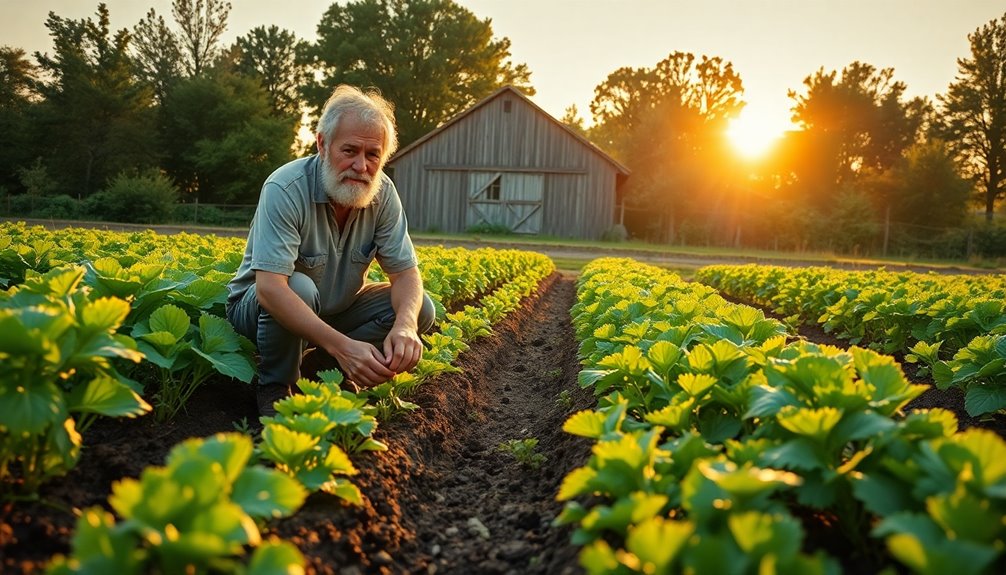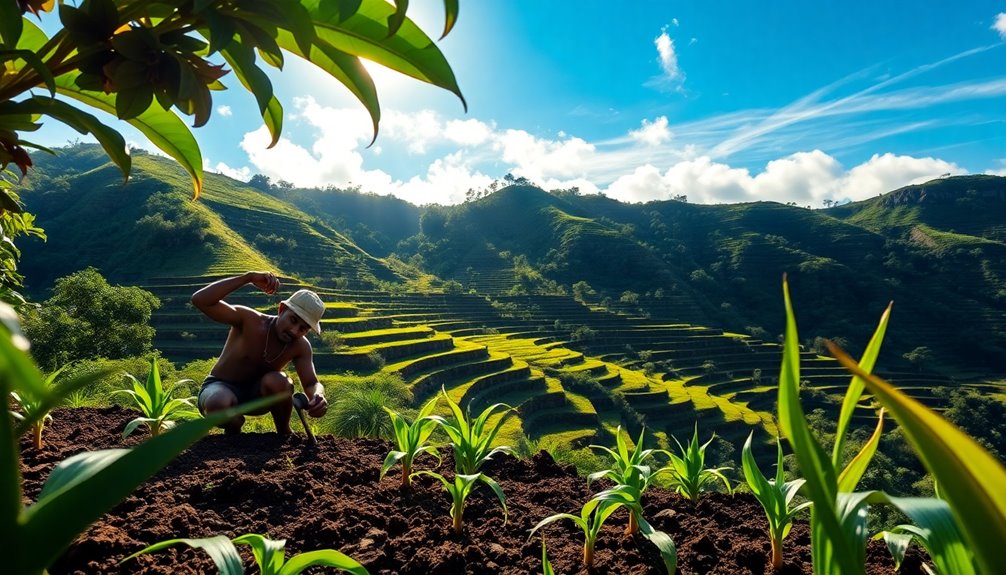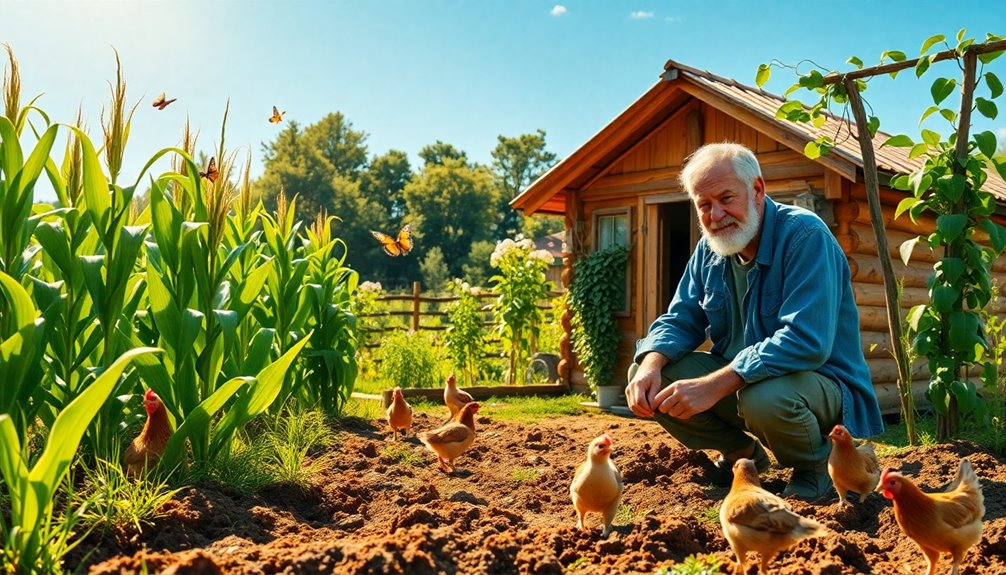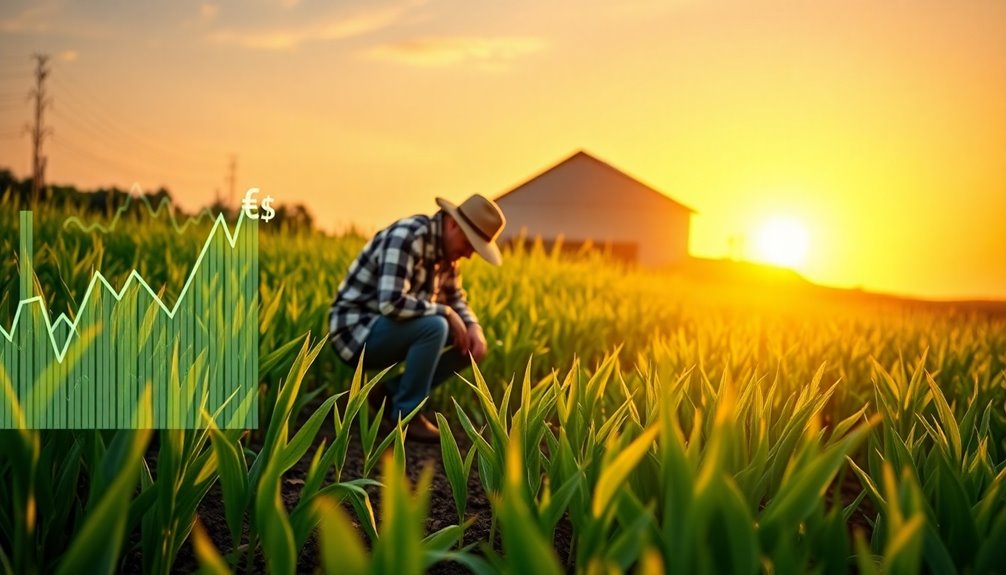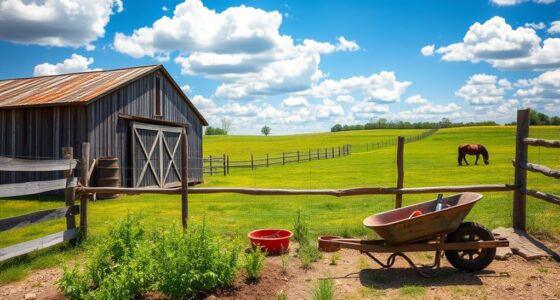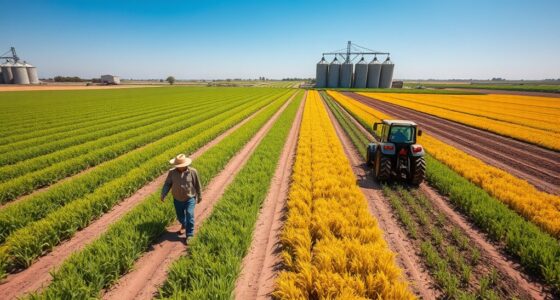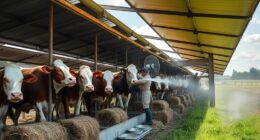Subsistence farming is all about achieving self-sufficiency by growing food primarily for your own needs. This traditional practice allows you to minimize reliance on external markets and develop a sustainable way of life. You can focus on diverse crops, utilize organic methods for soil health, and adapt to local climates for better resilience. Techniques like crop rotation and agroforestry not only enhance productivity but also promote environmental stewardship. By embracing these principles, you'll boost your food security and strengthen community ties. Curious about how to implement these strategies effectively? There's much more to explore on this journey to self-sufficiency!
Key Takeaways
- Subsistence farming focuses on self-sufficiency, providing food primarily for personal consumption and reducing reliance on external sources.
- Techniques like crop diversification enhance resilience, improve nutrition, and reduce pest risks for sustainable farming.
- Sustainable soil management practices, such as organic amendments, boost long-term soil health and crop productivity.
- Implementing water conservation methods, like rainwater harvesting, ensures irrigation efficiency and supports crop viability in water-scarce areas.
- Utilizing heat-tolerant and drought-resistant crop varieties helps maintain productivity despite climate challenges, ensuring food security.
Understanding Subsistence Farming
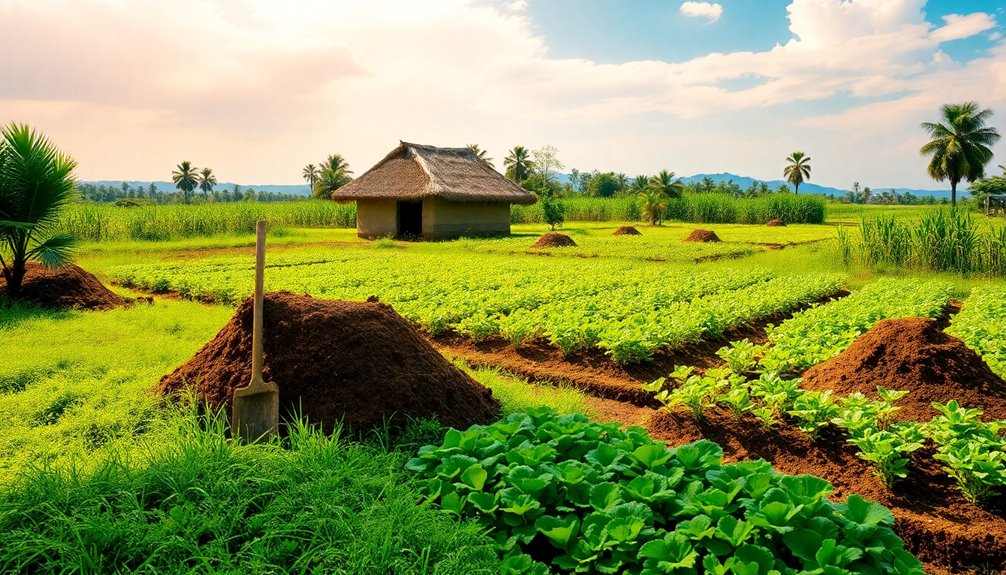
While many agricultural practices focus on maximizing profit, subsistence farming prioritizes self-sufficiency and food security for families. This practice, common in rural areas, allows smallholder farmers to grow crops primarily for their own consumption, reducing reliance on external food sources.
By using traditional farming methods like crop rotation and intercropping, you can enhance soil health and maintain sustainable living. It's vital to understand that subsistence farming not only supports local economies but also plays an important role in poverty reduction.
With around 2 billion people engaged in this practice globally, it emphasizes the importance of adaptability to local environments and cultural significance, ensuring that communities stay resilient and food secure in the face of challenges.
Key Characteristics of Subsistence Agriculture
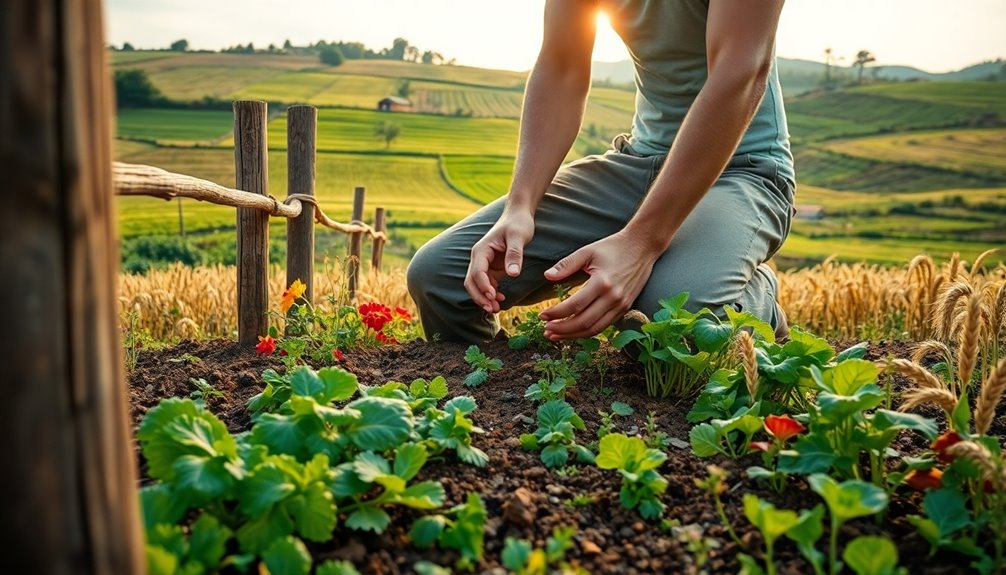
Subsistence agriculture is defined by its focus on producing food primarily for personal consumption, guaranteeing families can meet their basic dietary needs. This type of farming is practiced on small plots of land, utilizing traditional farming methods and relying heavily on family labor. By growing staple crops like rice, maize, and cassava, farmers contribute considerably to food security in their communities.
| Characteristic | Description | Importance |
|---|---|---|
| Land Size | Small plots of land | Limits production but guarantees focus on personal needs |
| Farming Methods | Traditional techniques | Sustainable and environmentally friendly |
| Labor Source | Family labor | Strengthens family bonds and reduces costs |
| Crop Selection | Staple crops | Essential for nutritional needs and local diets |
| Soil Management | Enhancing soil fertility | Improves productivity over time |
Types of Subsistence Farming
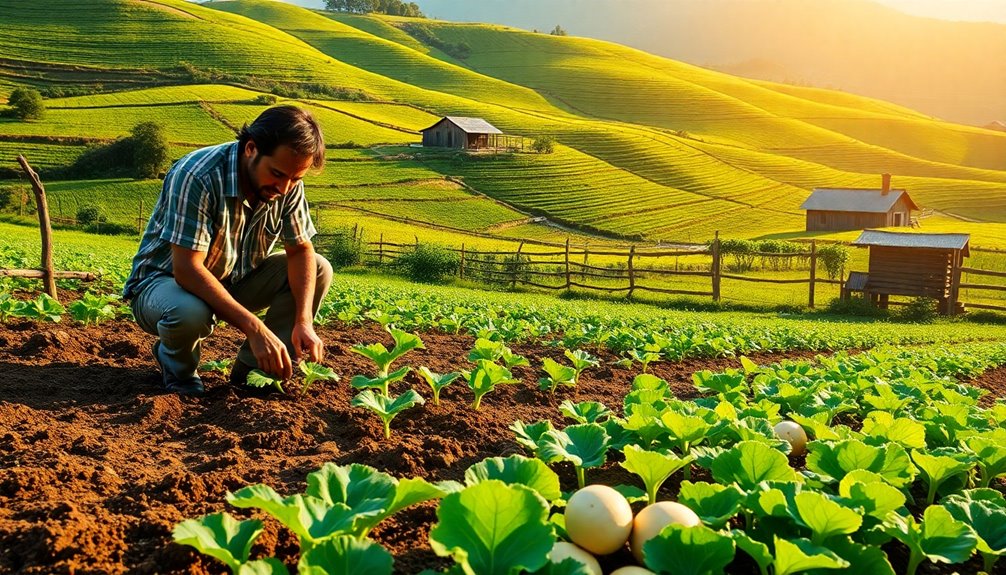
When you explore the types of subsistence farming, you'll find practices like shifting agriculture, which involves clearing land for short-term crop use.
You'll also encounter intensive farming methods aimed at maximizing output from small areas, and nomadic herding techniques that follow livestock across various landscapes.
Each of these methods showcases unique adaptations to the environment and community needs.
Shifting Agriculture Practices
Shifting agriculture, often visualized as a cycle of clearing, planting, and resting, plays an essential role in many tropical communities. This practice, also known as slash-and-burn agriculture, relies heavily on traditional knowledge to maintain soil fertility.
Farmers typically follow these steps:
- Clear a forested area to cultivate crops like maize, cassava, and millet.
- Plant and harvest for a few years, guaranteeing sustainable yields.
- Abandon the site for 2-3 years, allowing the land to regenerate.
While shifting agriculture can be sustainable at low population densities, it risks deforestation and soil erosion when practiced excessively.
Additionally, challenges like climate change threaten this age-old method, demanding adaptations to guarantee its continued viability.
Intensive Farming Methods
Intensive farming methods, a cornerstone of subsistence agriculture, maximize crop yields on small plots of land through high labor input and innovative techniques.
In intensive subsistence farming, you can cultivate multiple crops annually, utilizing practices like crop rotation and intercropping to enhance soil fertility. This approach is essential for smallholder farms, especially in densely populated regions where food production is important.
By focusing on high-yielding varieties and sustainable practices, you not only improve local food security but also support your community's economy. Additionally, integrating natural pain relievers like turmeric into your diet can help maintain health and productivity, which is vital for effective farming.
With around 80% of the world's smallholders engaged in subsistence farming, these methods play a significant role in providing diverse, nutritious crops while addressing the challenges posed by climate change and limited access to modern technology.
Nomadic Herding Techniques
Nomadic herding techniques represent an essential form of subsistence farming that revolves around the seasonal movement of livestock to access fresh pastures and water.
Practiced mainly in regions like central Asia and Africa, this method supports food security by providing crucial resources.
Here are three key aspects of nomadic herding:
- Migration Patterns: Herders adapt their routes based on climate change, ensuring livestock have access to grazing lands year-round.
- Livestock Diversity: Common animals include cattle, sheep, and camels, each suited to specific environments and traditional practices.
- Community Trade: Herders often engage in trade with settled populations, bolstering local economies and enhancing food security.
Despite its benefits, nomadic herding faces challenges from climate change and land use conflicts, threatening these traditional practices.
Historical Context of Subsistence Practices
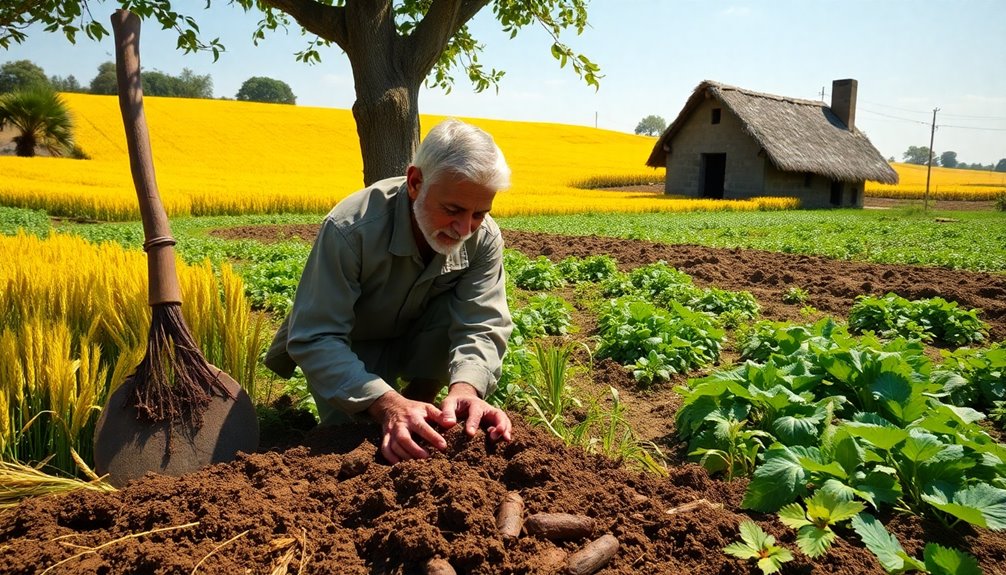
Throughout history, people have relied on subsistence farming as a fundamental means of survival. Originating over 12,000 years ago during the Neolithic Revolution, this agricultural practice allowed small communities to cultivate food and achieve self-sufficiency.
It laid the groundwork for permanent settlements and the rise of modern civilization. For many centuries, subsistence farming was the dominant agricultural practice, but its prominence began to wane with the advent of commercial agriculture and market-based capitalism.
By the early 20th century in Europe, subsistence farming had markedly declined. In North America, the 1930s and 1940s saw a similar trend due to tenant farmer movements.
Even in Central and Eastern Europe, semi-subsistence agriculture faced challenges in the wake of economic shifts post-1990.
Modern Subsistence Farming Techniques

When you think about modern subsistence farming techniques, crop diversification and sustainable soil management come to the forefront.
By mixing different crops, you can enhance resilience and reduce pests, while techniques like composting and cover cropping boost soil health.
These strategies not only support your farm's productivity but also contribute to long-term sustainability.
Crop Diversification Strategies
Crop diversification is an essential strategy in modern subsistence farming that can greatly enhance food security and resilience. By adopting this approach, you can guarantee a more stable and productive farming system.
Here are three effective crop diversification techniques:
- Intercropping: Grow two or more crops simultaneously, like maize and beans, to maximize land use and minimize pest risks.
- Agroforestry Practices: Integrate trees and shrubs with your crops to improve biodiversity and soil health, while providing additional resources like fodder.
- Drought-Resistant Crop Varieties: Use heat-tolerant crops to maintain productivity despite climate challenges, guaranteeing food security for your family.
Implementing these strategies can lead to sustainable yield improvements and a more resilient farming system for subsistence farmers.
Sustainable Soil Management Techniques
Soil health is the foundation of successful subsistence farming, and employing sustainable soil management techniques can transform your agricultural practices.
Focusing on sustainable agriculture, you should incorporate organic amendments like compost and manure to boost soil fertility and moisture retention.
Implementing conservation tillage methods, such as no-till practices, will help prevent erosion while preserving soil structure and microbial life.
Additionally, using cover crops during fallow periods can suppress weeds, enhance soil fertility, and fix nitrogen, making your system more resilient.
Integrating agroforestry by mixing trees with your crops and livestock not only improves soil quality but also diversifies your income sources.
Economic Benefits of Self-Sufficiency
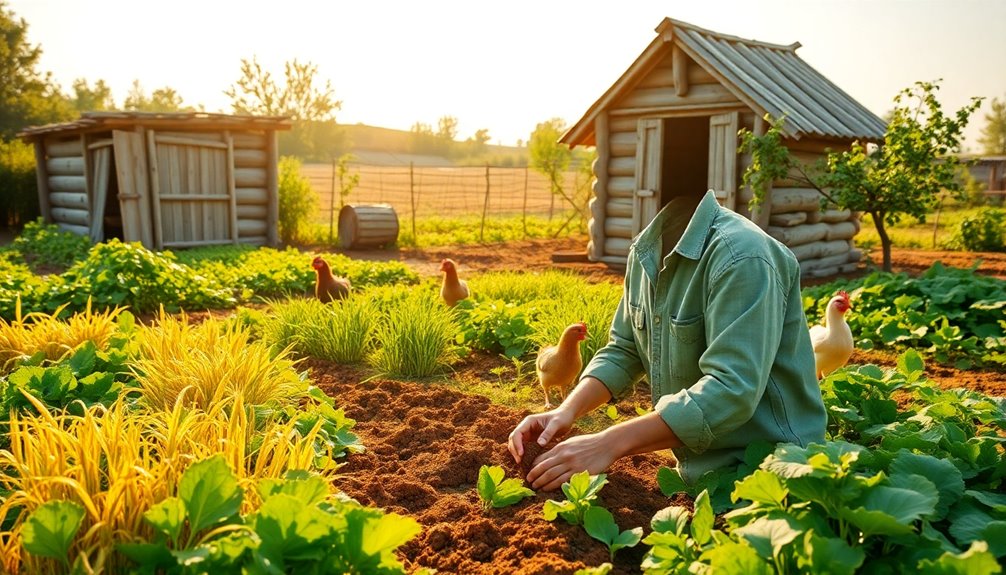
Self-sufficiency in subsistence farming offers substantial economic benefits that can transform the lives of countless households. By growing your own food, you can enhance food security and reduce reliance on market sources, which is essential for economic stability.
Here are three key benefits:
- Cost Savings: Producing your own food can cut grocery expenses by up to 30%.
- Community Engagement: Barter systems allow you to trade surplus goods, fostering local economies and strengthening community ties.
- Health Improvements: Cultivating diverse crops boosts your nutritional intake, reducing healthcare costs related to malnutrition.
These practices not only improve agricultural productivity but also play a significant role in poverty alleviation, ensuring income stability for low-income families.
Cultural Importance of Subsistence Farming
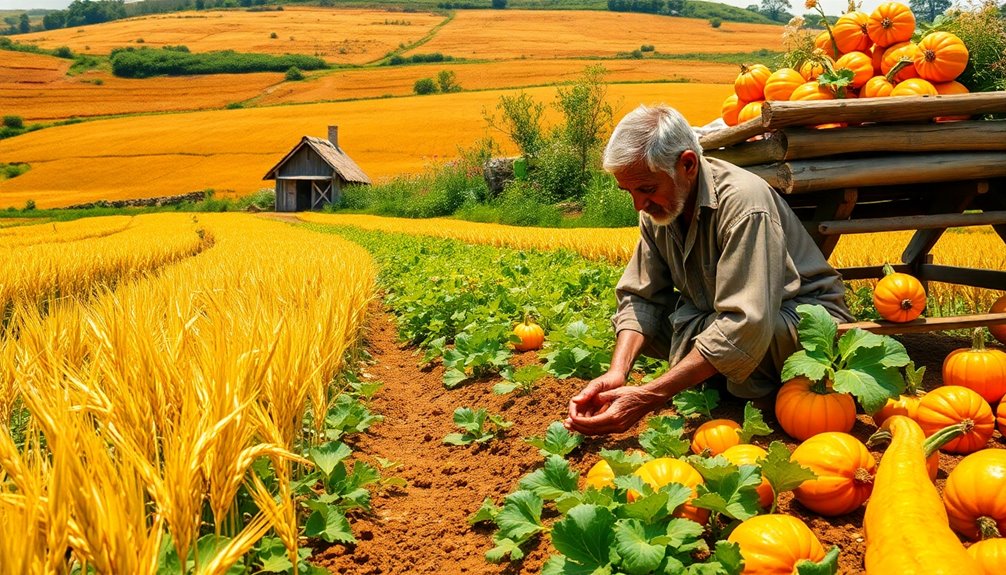
Embracing the traditions of subsistence farming not only nurtures your connection to the land but also preserves essential cultural heritage. By engaging in these practices, you help maintain traditional agricultural knowledge passed down through generations, fostering community identity. Subsistence farming empowers you and your community, enhancing food sovereignty and promoting self-sufficiency. It supports local economies through barter systems, effectively utilizing local resources while reducing cash dependence. Additionally, these practices enhance biodiversity and guarantee the sustainable use of land, contributing to environmental stewardship.
| Aspect | Description | Importance |
|---|---|---|
| Cultural Heritage | Maintains traditional agricultural practices | Fosters community identity |
| Food Sovereignty | Empowers local food production | Reduces reliance on external sources |
| Local Economies | Promotes barter systems | Strengthens community resilience |
| Biodiversity | Encourages diverse crop cultivation | Guarantees sustainable land use |
Challenges in Subsistence Agriculture
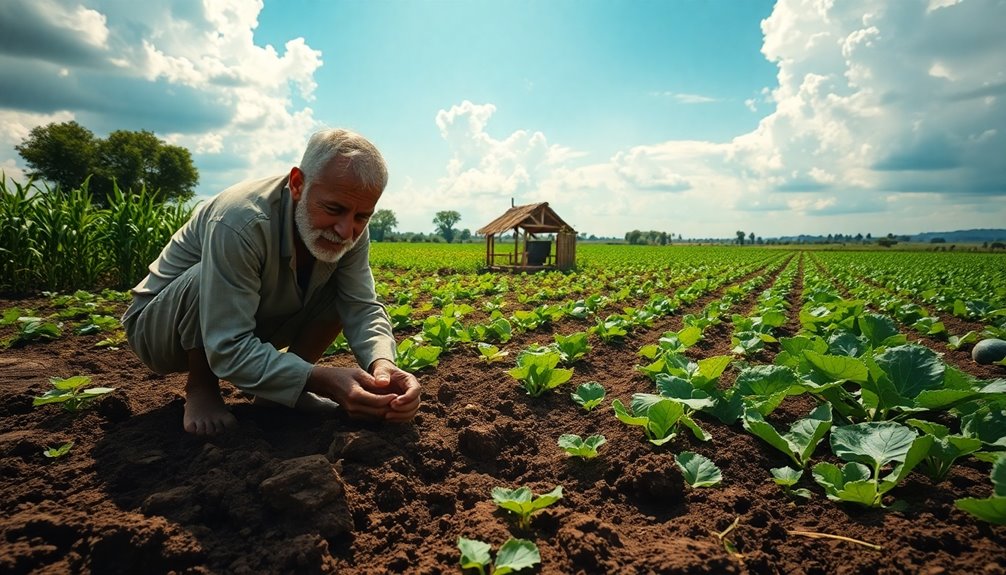
Frequently, subsistence agriculture faces numerous challenges that threaten both food security and the livelihoods of farmers. You might encounter the following issues:
- Climate Change: Rising temperatures can lower crop yields, making it difficult to feed your family and community.
- Soil Degradation and Water Scarcity: These factors undermine your production stability, leading to decreased harvests and increased vulnerability.
- Access to Resources: Limited access to quality seeds and fertilizers hampers your farming efficiency and economic viability.
Additionally, market fluctuations can make it tough to sell surplus produce at fair prices, trapping you in a cycle of poverty.
These economic vulnerabilities complicate your ability to invest in improvements and adapt to changing conditions, further affecting your food security.
Adapting to Climate Change
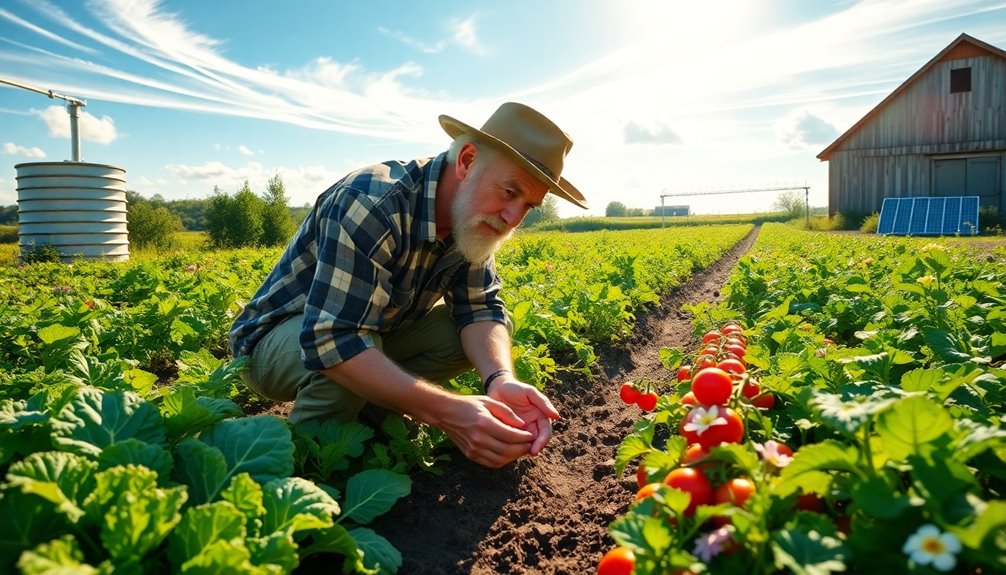
As you face the challenges of climate change in subsistence farming, adopting sustainable practices becomes essential.
By embracing crop diversity strategies, you can boost resilience against unpredictable weather patterns.
Implementing these methods not only helps secure your food supply but also supports the health of your land. Additionally, integrating renewable energy sources can further enhance the sustainability of your farming practices.
Sustainable Farming Practices
Sustainable farming practices play an essential role in helping subsistence farmers adapt to the challenges posed by climate change. By implementing specific techniques, you can enhance resilience and guarantee food security:
- Agroecology: Utilize crop rotation and intercropping to improve soil health and biodiversity.
- Rainwater Harvesting: Manage water resources effectively, securing irrigation during droughts.
- Conservation Agriculture: Adopt minimal tillage and cover cropping to boost soil carbon sequestration and reduce greenhouse gas emissions.
Additionally, using heat-tolerant crop varieties and organic fertilizers can maintain productivity amid rising temperatures.
Integrating traditional knowledge with these modern sustainable farming practices allows you to create adaptive strategies that not only tackle climate challenges but also preserve your cultural agricultural heritage.
Crop Diversity Strategies
Embracing crop diversity strategies is essential for adapting to the ever-changing climate. By implementing techniques like intercropping and polyculture, you can enhance soil health and improve resilience against climate change.
Using traditional knowledge to select heat-tolerant or drought-resistant crops not only helps you adapt but also maintains nutritional diversity in your diet. Incorporating legumes into your crop rotations boosts soil fertility and provides additional food sources, mitigating the impacts of climate variability.
Agroforestry practices can further augment your farming system by offering shade, improving microclimates, and increasing biodiversity. Evidence shows that farms employing crop diversity can achieve up to 25% higher productivity during climate stress, markedly supporting food security for your family. Additionally, adopting eco-friendly practices in wood stove usage can provide sustainable heating solutions that complement your self-sufficient lifestyle.
Sustainable Practices for Resilience
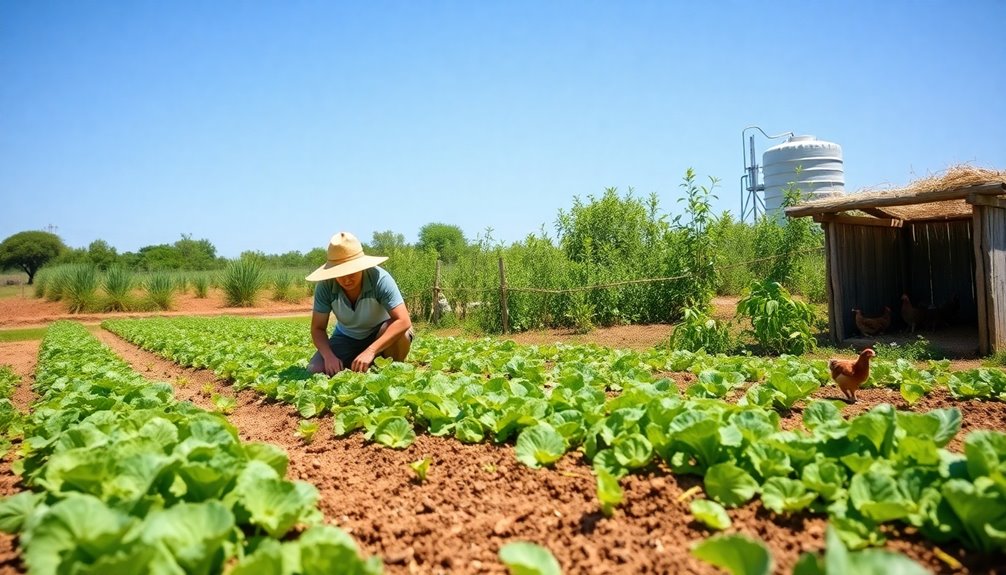
In recent years, subsistence farmers have turned to sustainable practices to build resilience against the challenges posed by climate change.
By embracing agroecology, these farmers enhance crop diversity and utilize heat-tolerant varieties.
Here are three key techniques you can adopt:
- Crop Rotation and Intercropping: These methods maintain soil health, boost yields, and reduce pests.
- Water Conservation Strategies: Implement rainwater harvesting and efficient irrigation to optimize resources in water-scarce areas.
- Community Forestry: Integrate trees into your farming system to enhance biodiversity and provide additional resources like fuel and fodder.
Additionally, many farmers are exploring various water conservation techniques to maximize their agricultural efficiency.
Frequently Asked Questions
What Is the Meaning of Subsistence Farming?
Subsistence farming means you grow food primarily for your own needs rather than for sale. It focuses on self-sufficiency, allowing you to rely on local resources and traditional farming methods.
In this system, you might practice techniques like crop rotation and use natural fertilizers to enhance soil health. This approach not only provides your basic food requirements but also contributes to local economies and food security, especially in developing regions.
What Are Methods Used for Subsistence Farming?
When you practice subsistence farming, you can use several effective methods.
Crop rotation keeps your soil healthy, while polyculture allows you to grow multiple crops together, enhancing biodiversity.
Agroforestry integrates trees with your crops, improving soil quality and providing extra products.
If you're on sloped land, terracing helps prevent erosion.
Finally, composting with organic waste enriches your soil, promoting sustainable practices for long-term productivity and self-sufficiency in your farming efforts.
What Is Subsistence Agriculture AP Human Geography?
Imagine a gardener tending to a small plot, cultivating just enough to feed their family. That's what subsistence agriculture represents in AP Human Geography—it's about communities growing food primarily for themselves.
You'll learn how this practice shapes food security, cultural traditions, and local economies, particularly in developing regions.
As you explore the diverse methods used, you'll see how these techniques adapt to the land, sustaining livelihoods and fostering resilience among populations.
What Are Examples of Subsistence?
You'll find several examples of subsistence practices around the world.
For instance, in rural India, families often grow vegetables in their home gardens to meet their food needs.
In China, smallholder farmers work on tiny plots, primarily for personal consumption.
Additionally, nomadic herding is common in central Asia, where herders migrate with their livestock to find fresh grazing land.
Shifting agriculture also showcases how communities adapt their farming techniques to guarantee food security.
Conclusion
To summarize, subsistence farming plays an essential role in global food security, with around 2 billion people relying on it for their livelihoods. By embracing these age-old techniques, you can achieve self-sufficiency while preserving cultural traditions. As you explore modern practices and adapt to challenges like climate change, you'll not only enhance your resilience but also contribute to a sustainable future. So, why not start implementing some of these techniques in your own life today?

